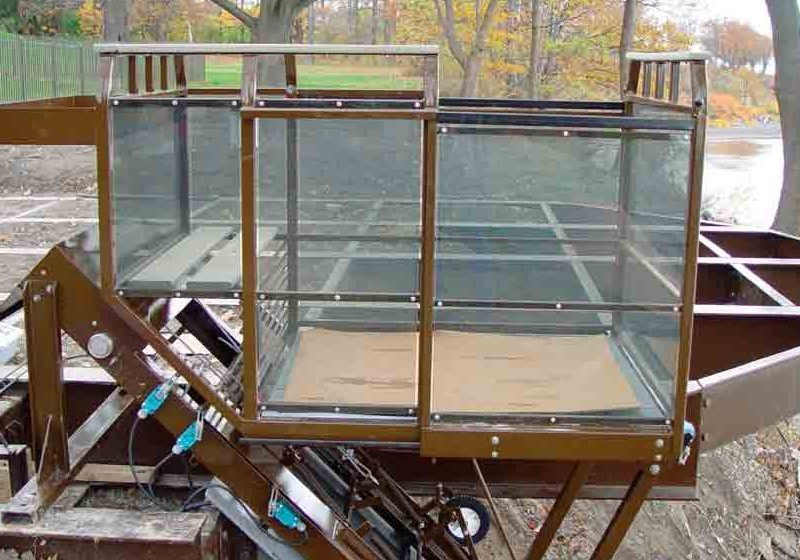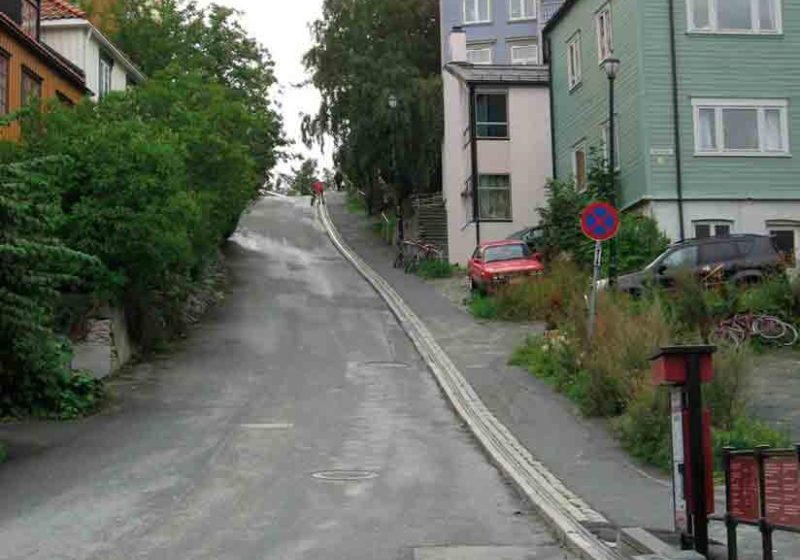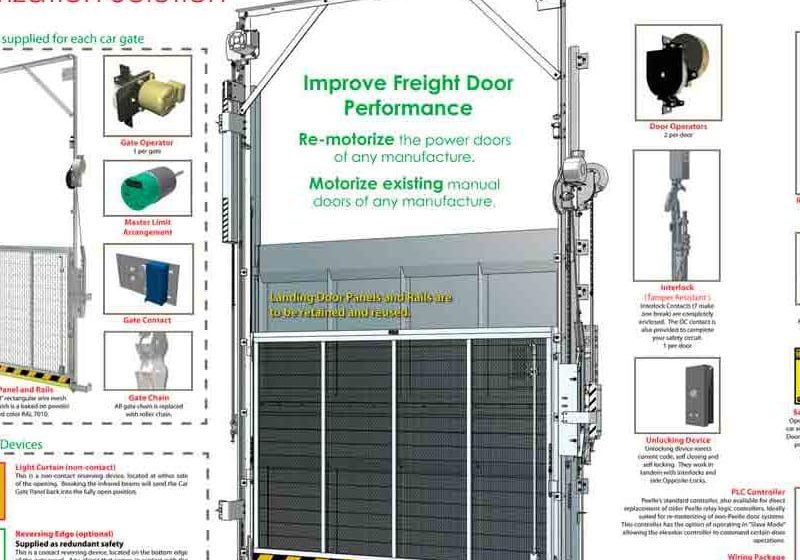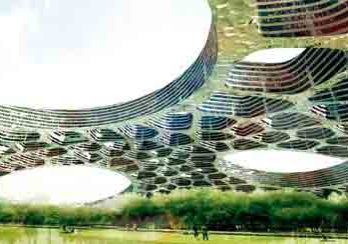Linear Synchronous Motor Elevators Become a Reality
May 1, 2012

The benefits of linear synchronous technology for industrial and passenger elevators
by James G. Wieler and Dr. Richard D. Thornton
For more than a decade, the U.S. Navy has been progressing toward the concept of an “all-electric” ship. The primary objective is to eliminate shipborne hydraulic, pneumatic, steam and mechanically driven systems that are inefficient, lack required performance capability and demand extensive maintenance. MagneMotion’s Linear Synchronous-Motor (LSM) technology has been selected as part of the Navy’s solution.
MagneMotion’s development of the Advanced Weapons Elevator (AWE) aircraft-carrier elevator began in 2003 with the design and construction of a proof-of-concept system. MagneMotion, partnered with Federal Equipment Co. (FEC) of Cincinnati, was one of two teams awarded contracts in 2004. The system has since been qualified through a number of functional and environmental tests, including shock, vibration and electromagnetic interference. Production of 11 AWE elevator sets was completed in 2011, and FEC and MagneMotion have since begun elevator production for the next carrier.
The LSM system eliminates the need for hydraulics, counterweights, cables and pulley systems. It is faster, safer, environmentally friendly and more efficient, and has a higher lift capacity than existing Navy munitions elevators. With the ability to transport loads over 20 T., this system could also provide a solution for many commercial elevators.
LSM Elevator Technology
A previous paper (ELEVATOR WORLD, September 2006) discussed the design and advantages of LSM elevators in some detail, so only the key features will be discussed here. MagneMotion’s elevators use LSM stators and guide rails on the hoistway wall, and permanent-magnet (PM) arrays on elevator cabs that have guidance wheels and brakes. Currents in the LSM stator windings create a magnetic field that interacts with PMs to produce force. Controllers create excitation currents that move the cab per instructions from a control system, which includes control of acceleration, velocity and destination. Precise position is inherent in the design of LSM propulsion, so automatic control is simplified. Each vehicle is independently controlled, and many vehicles can operate in a single hoistway. Inductive power transfer is used to charge onboard energy-storage components that power the cab’s lighting and communication facilities.
Brakes are the most important safety feature for any elevator, including LSM-propelled systems. For the AWE application, to achieve a high level of safety, we use redundant mechanical brakes. When stationary, the cab is supported by mechanical wedge brakes. When in motion, the LSM can provide all braking. When a platform stops, electrically operated wedge brakes on the platform act on the guide rails. Springs cause the brakes to engage when power is not applied and solenoids hold the springs back when the brakes disengage. In this approach, the brakes are “failsafe,” because they engage in the event of power loss. These brakes are “self energizing,” which means once they begin to grip the stator rails, the braking force applied to the vehicle causes the grip to tighten, increasing braking force. Brakes are designed so the vehicle can be lifted a short distance while brakes are engaged. This feature is used to measure platform load and verify the elevator is not overloaded before releasing the brakes.
Benefits
Benefits of the LSM elevator system include:
- No ropes: The hoistway can extend to any height, because there is no rope weight with which to contend.
- Higher speed and capacity: LSM propulsion allows speeds in excess of 20 mps with little or no increase in cost. Multiple elevator cabs can travel independently within a single shaft, increasing throughput and efficiency.
- Lower maintenance costs: LSM cable-less elevators have fewer moving parts, reducing maintenance, while increasing reliability. The modular design allows rapid replacement of components. The LSM can decelerate, accelerate and stop the cab at its designated location before parking brakes need to be applied, resulting in reduced brake wear.
- Safety: LSM elevators are designed with a sophisticated control system that provides positive vehicle feedback control, anti-collision logic and redundant brakes.
- Flexible configuration: LSM elevators can propel a vehicle in any direction, and cabs can be switched from hoistway to hoistway, enabling the creation of “one-way” hoistways with multiple cabs in each. Modular stators allow the height of the elevator to be customized at installation and extended in the future with minimal disruption. LSM elevators can also accommodate inclined layouts, providing an alternative to stairways or escalators.
Industrial Elevators
The Navy’s AWE project has proven that LSM elevators can be deployed as freight elevators and vertical-platform lifts for applications in various industrial environments. Single- or multi-path stators can be used to facilitate transport of the heaviest loads, from cargo containers to loaded lift trucks, passenger vehicles or bulk inventory. MagneMotion’s industrial elevator systems can be integrated with automated storage and retrieval systems and existing warehouse logistic systems to optimize the vertical transport and overall materials-handling process. As an example, LSM vertical lifts can be designed for transporting vehicles in automated parking garages.
Passenger Elevators
MagneMotion’s LSM elevator technology serves as an alternative to hydraulic or rope elevators. Unlike roped elevator designs, LSM technology is more efficient at higher speeds. More importantly, when commercial elevators are limited by length, capacity or environment, LSM Elevators can have multiple cars in a shaft, reducing the number of shafts in a building and creating more rentable space.
An important future alternative is to provide horizontal motion of cabs between adjacent hoistways. This would allow scheduling similar to that used by automated people movers. The control options are almost unlimited but would likely involve switching at intermediate levels and several cabs for each hoistway. MagneMotion has constructed LSM-propelled transport systems for horizontal travel and designed switches that allow path change. This same idea can be implemented for commercial, residential, industrial and vertical-storage systems and provide a high level of safety. With horizontal switching, the capacity of each hoistway can be significantly increased, with minimal added cost for a switching system.
Commercialization
The force produced by an LSM depends on the size of the stators and magnets, and duty cycle. Unlike rotary elevator motors, each stator operates with a low duty cycle, allowing higher force without overheating. Depending on the force required, it may be desirable to have more than one LSM – the Navy AWE motor uses four LSMs, one on each corner. The LSM stators run the length of the hoistway, so they tend to dominate the cost. The width of the LSM stators can be reduced using a longer magnet array, making it desirable to use the longest magnet array possible.
Elevator braking systems are well understood. LSM elevators use a brake only to lock the cab in place after it has reached its destination or during emergencies. It is unlikely that the brakes designed for Navy AWE applications would be cost competitive compared to standard elevator-braking products. Initial investigation shows there are several manufacturers of rail brakes suitable for commercial applications. The Navy AWE application required substantial design features and testing to meet safety and environmental requirements, so we are confident that conventional American Society of Mechanical Engineers elevator codes can be met for a commercial design.
Conclusion
These elevators have passed numerous qualification tests and proven to be a reliable and safe way to move heavy munitions without ropes or hydraulics. Commercialization of the elevator for passenger use will require further investment, but we believe there is a promising future. MagneMotion is investigating opportunities for the continued development of this important market for LSM propulsion.
Get more of Elevator World. Sign up for our free e-newsletter.









